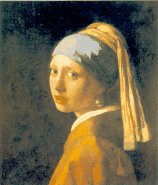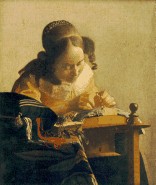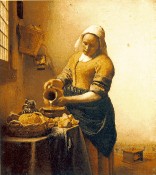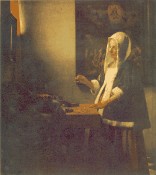by E.O.
Jan Vermeer was a Dutch painter in the 17th century. He was born on October 31, 1632 in a small town called Delft. Though his works were not well known in his time, all thirty-five of his paintings are widely appreciated now. Vermeer is considered one of the great Dutch artists, able to withstand much of the influence of Italy, France and Flanders, giving his painting a unique feeling and look.
 The Girl With a Pearl Earring The Hague, Mauritshuis |
This painting has been thought to be one of Vermeer's Daughters. This lovely girl is painted on a dark background, not made with lines, but with color. There is a softness about the picture that emphasizes the contrast in the colors, the blue turban, yellow veil and white collar. This picture has a quality that makes you stop and study.
Vermeer was the son of an art dealer and tavern keeper. When his father passed away in 1655, he took over his jobs. He married Catherina Bolnes in 1653 and eventually had 11 children. His job as an art dealer supported his family, but they were continuously in debt. In later years bankruptcy and political troubles of the time ruined his business. There is no record of him ever selling his paintings. In 1662 Vermeer entered an artists guild. He lived in a small, calm world and often used paintings as pawns for his debts.
Vermeer did not paint many pictures, but the ones we have give us insights into daily Dutch life, depicting calm scenes, where usually one or two figures are engaged in simple tasks. Many of his paintings depict simply furnished interiors with people involved at simple everyday tasks. While most of his paintings are of indoor scenes, two of his outdoor scenes, "The View of Delft" and "Street in Delft," are some of the best landscape paintings of the 1600's. The realistic looks of Vermeer's paintings help to make them popular with all who see them.
 View of Delft The Hague, Mauritshuis |
Many think that Vermeer painted this picture with the help of the "obscura," an optical device, like a camera that projects a view onto a flat screen. The background is lighted while the foreground is in shadow, the buildings are textured and the reflections in the water are made by highlights of pure white paint.
 The Lacemaker Paris, Louvre |
This is a miniature painting of a young girl delicately making lace. Painted in muted colors except for the flashes of brilliant red and yellow.
It is to be noted that this realistic look was achieved by altering reality with his artful use of light and shadow. This altering of reality made his paintings look more intense than would have been possible by just faithfully portraying what he saw.
 The Milkmaid Amsterdam, Rijjksmuseum |
This is one of Vermeer's most popular paintings. It depicts a sturdy main, engaged in every day duties, the painting is extremely realistic, vivid with strong and warm colors.
His paintings have a quality of peaceful balance, through use of subtle lighting, usually from the side of the room, pure perceptions and optical observations. Shadow is balanced to light, the space, color and tone have a dense simplicity. The predominant colors in Vermeer's paintings are subtle grays, blues and yellows.
 A Woman Holding a Balance Washington, National Gallery |
This woman holding a balance is standing in front of a picture of the last judgment, she weighs her decisions, her choice of a spiritual life or a material life. The room is dark except for a small beam of light from a window in the left-hand corner.
The precious carpets, silk, and objects come beautifully alive with Vermeer's glowing details. Vermeer used the pointillist method of painting. In this method individual points of color are used and when viewed these points make a picture. This type of painting makes for softer and more blurred lines, giving the painting a softer look.
Jan Vermeer died at the young age of 43 in 1672, leaving behind him his wife and 11 children. He was buried at the Church in Delft. He is thought to be one of the most famous Dutch painters, his paintings draw the eye to quiet contemplation of the calm and silent pure scenes.
|
Sources: |
"Paintings of Vermeer" at: www.ccsh.caltech.edu/~roy/vermeer/pop.html |
| "Vermeer in Washington" at: www.glyphs.com/art/vermeer/intro.html | |
| "Vermeer: a tiny history" at: www.ccsf.caltech.edu/~roy/vermeer/history/html | |
| "Vermeer, Jan", World Book Multimedia Encyclopedia. World Book Inc., 1999 |